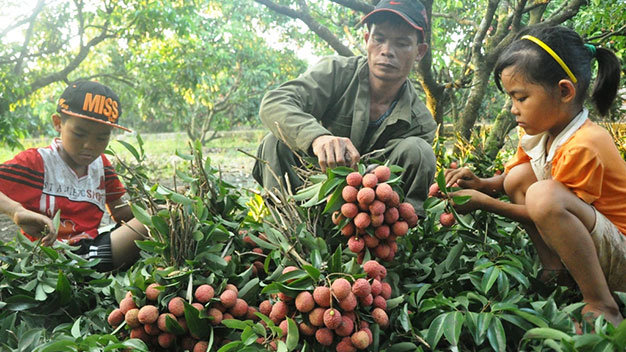Vietnamese lychee farmers still cannot breathe a sigh of relief after Australia announced it will open its door for the fruit given the rising yield this year, though both central and local authorities have moved to help raise domestic demand for it.
The Australian Department of Agriculture last Monday gave the green light for irradiation-treated lychees from Vietnam to be exported to the Australasian country, and it notified Australian importers about the approval to begin importing the fruit on the same day, according to news website abc.net.au.
Consignments of Vietnamese lychees are permitted to be air or sea freighted to Australia and must be inspected on arrival.
The go-ahead, coming after Vietnamese authorities applied for it 12 years ago, was released just in time for Vietnam's 2015 lychee harvest, which has two stages, from the middle to the end of May and from June to July 20, the Australian news website reported.
Head of Australia's Lychee Growers Association, Derek Foley, from Electra, Queensland, told the Australian news website he was not worried about Vietnamese imports competing with local fruit as it will not clash with the Australian season, which falls at Christmas.
The Vietnamese government is hoping this will be the first of many tropical fruits it can export, including mangoes and dragon fruit.
The two largest lychee-growing areas of Vietnam are the northern provinces of Bac Giang and Hai Duong, which are expecting to harvest a total of 200,000 metric tons of fresh lychees in the 2015 crop, a 28.2 percent year on year rise, according to the Vietnam Trade Promotion Agency.
Domestic consumption prioritized
According to the Ministry of Industry and Trade of Vietnam, about 60 percent of the lychees, or 120,000 metric tons, will be sold domestically, while the remaining 40 percent, or 80,000 metric tons, including 85 percent of fresh fruits and 15 percent of dried and frozen fruits, are set aside for export to a number of foreign markets like Laos, Cambodia, Thailand, Singapore, the U.S., Australia, Japan, South Korea, and Europe.
The Domestic Market Department under the ministry is working with relevant agencies to boost lychee sales this year by promoting domestic consumption, especially in the south, which is expected to consume 43 percent of the total output set aside for the local market, as the price of the fruit is expected to remain unchanged from that in 2014.
During the lychee season last year, Vietnamese authorities began to promote domestic consumption in a bid to find a new outlet for the fruit after fewer Chinese traders bought it during the period.
Many shipments of the fruit, which were previously assigned to travel north to the border with China, were redirected south, which finally brought in a fruitful result with 60-70 percent of the shipments sold, according to the ministry.
In addition, the authorities were also looking elsewhere to attract consumers from non-traditional markets such as Eastern Europe, the Middle East, and Africa.
In 2014, global lychee production stood at 2.6 million metric tons, of which China and India accounted for 57 percent and 24 percent respectively, followed by Vietnam with around six percent, or about 156,000 metric tons.
While most lychees produced in China and India are consumed domestically, Vietnam exports up to 40 percent of its total production, most of which is conducted via cross-border trade, which leads to the country not being recognized as a big lychee exporter in the global market, according to the Vietnam Trade Promotion Agency.
Like us on Facebook or follow us on Twitter to get the latest news about Vietnam!


















































